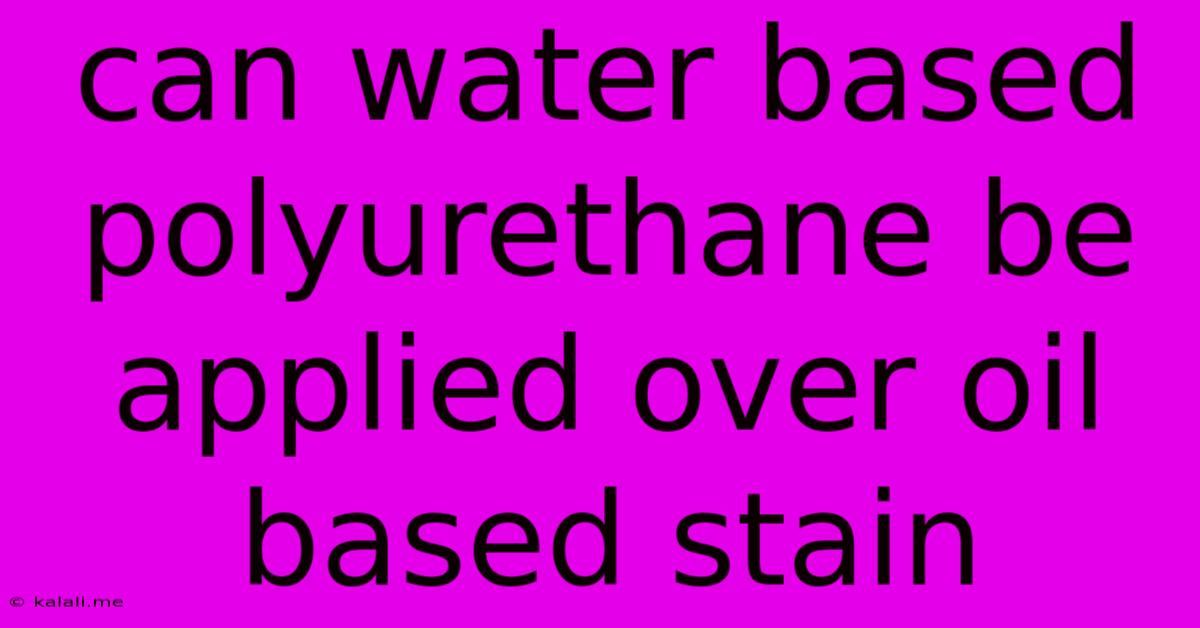Can Water Based Polyurethane Be Applied Over Oil Based Stain
Kalali
May 24, 2025 · 3 min read

Table of Contents
Can Water-Based Polyurethane Be Applied Over Oil-Based Stain? The Definitive Guide
Meta Description: Wondering if you can apply water-based polyurethane over oil-based stain? This comprehensive guide explores the compatibility, potential problems, and best practices for achieving a durable and beautiful finish. Learn about surface preparation, the right products, and troubleshooting common issues.
Applying a finish to your woodworking project is the final, crucial step. Choosing the right combination of stain and topcoat is essential for a beautiful and long-lasting result. A common question among DIYers and professionals alike is: can you apply water-based polyurethane over oil-based stain? The short answer is: generally, no, not without significant preparation. This article will delve into the reasons why, and explain the best course of action.
Why Water-Based Polyurethane and Oil-Based Stain Don't Mix Well
The core problem lies in the fundamental differences between oil-based and water-based products. Oil-based stains penetrate deep into the wood, creating a rich, even color. They also leave behind a significant oil residue on the surface. Water-based polyurethane, on the other hand, is repelled by this oil. This incompatibility can lead to several issues:
- Poor Adhesion: The polyurethane simply won't stick properly to the oily surface, leading to peeling, bubbling, or a generally uneven finish. This is a major concern for durability.
- Blooming: The oil in the stain can rise to the surface and react with the water-based polyurethane, creating a cloudy or milky appearance (blooming). This ruins the aesthetic appeal of your project.
- Uneven Finish: Areas may absorb the polyurethane differently, leading to inconsistencies in the sheen and appearance.
Preparing for Success: Can you still use water-based Polyurethane?
While directly applying water-based polyurethane over oil-based stain is generally discouraged, it's not impossible with the right preparation. Thorough preparation is key to successful adhesion and a beautiful finish. Here's how to approach this challenge:
- Cleaning: Begin by thoroughly cleaning the stained surface with a high-quality degreaser. This removes any excess oil residue left behind by the stain. Make sure to allow ample drying time.
- Sanding: After cleaning, lightly sand the surface with fine-grit sandpaper (around 220-grit). This creates a slightly rough surface that the polyurethane can better grip. Remove all sanding dust with a tack cloth.
- Testing: Before applying the polyurethane to the entire surface, test it on a small, inconspicuous area. This helps identify any potential problems early on.
Important Considerations:
- Drying Time: Ensure the oil-based stain is completely dry before you begin cleaning and sanding. Allow significantly longer than the manufacturer's recommended drying time.
- Ventilation: Work in a well-ventilated area when using any finishing products, including stains and polyurethane.
- Type of Polyurethane: Even with meticulous preparation, the risk of problems remains. Consider using an oil-based polyurethane if you’re hesitant to risk the problems associated with the incompatibility.
The Best Approach: Choosing Compatible Finishes
The easiest and most reliable approach is to simply use compatible products from the start. Sticking to either oil-based or water-based products throughout the entire process ensures a significantly higher chance of success.
- Oil-Based Stain and Oil-Based Polyurethane: This combination is the classic and often preferred method, providing a durable and long-lasting finish.
- Water-Based Stain and Water-Based Polyurethane: This is a modern and increasingly popular choice, offering low VOC (volatile organic compound) options and easier cleanup.
Ultimately, achieving a perfect finish requires careful planning and preparation. While it's possible to use water-based polyurethane over oil-based stain with extensive preparation, choosing compatible finishes from the outset is a more reliable method for avoiding issues and achieving a professional-looking result.
Latest Posts
Latest Posts
-
Faced Or Unfaced Insulation For Crawl Space
May 25, 2025
-
How Do You Open A Garage Door Without The Remote
May 25, 2025
-
Is Tuna Cat Food Good For Cats
May 25, 2025
-
Assassins Creed Black Flag How To Use Mortars
May 25, 2025
-
3 Way Switch With 4 Way Switch
May 25, 2025
Related Post
Thank you for visiting our website which covers about Can Water Based Polyurethane Be Applied Over Oil Based Stain . We hope the information provided has been useful to you. Feel free to contact us if you have any questions or need further assistance. See you next time and don't miss to bookmark.